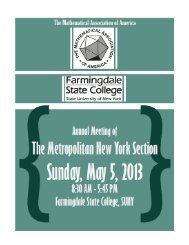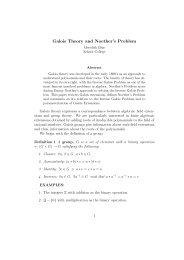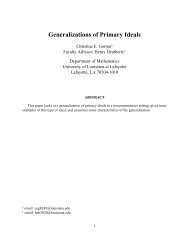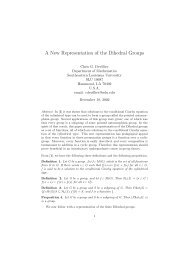Program - MAA Sections - Mathematical Association of America
Program - MAA Sections - Mathematical Association of America
Program - MAA Sections - Mathematical Association of America
You also want an ePaper? Increase the reach of your titles
YUMPU automatically turns print PDFs into web optimized ePapers that Google loves.
Abstract Number: 13. Plasma enhanced physical vapor deposition (PEPVD) is one proposed<br />
method to coat nan<strong>of</strong>ibers and nanostructures with thin film materials. Experimental efforts in<br />
coating electrospun polymer nan<strong>of</strong>ibers suggest a relationship between coating morphology and<br />
operating conditions. This motivates a theoretical model for coating growth. The model presented<br />
here assumes a coating growth that is uniform along the axial dimension <strong>of</strong> the nan<strong>of</strong>iber but nonuniform<br />
in the radial direction. The concentration <strong>of</strong> vaporized aluminum surrounding the coating<br />
growth is non-uniform due to the geometry <strong>of</strong> the coating growth; therefore modeling the<br />
morphology <strong>of</strong> the growth requires that the surrounding concentration field be determined. The<br />
concentration field is then supplied to an evolution equation. The mode <strong>of</strong> mass transport is<br />
diffusion; therefore the mathematical model consists <strong>of</strong> Laplace's equation over a polar domain. The<br />
domain is an annulus with an irregular inner boundary. A finite difference method is employed to<br />
solve the system. The irregular inner boundary geometry, as well as a complicated inner boundary<br />
condition, requires that interpolation schemes and ghost points be used at boundary points. The<br />
resulting matrix system is solved with a block SOR iterative method.<br />
Equivalent Norm Coefficients<br />
Matthew J Ward<br />
Student, Youngstown St Univ<br />
Abstract Number: 14. Standard pro<strong>of</strong>s for “all norms defined on a finite dimensional vector space<br />
are equivalent” can be long and complicated. A simpler approach is examined through the use <strong>of</strong><br />
generalized equivalent norm coefficients.<br />
Outwitting the Lying Oracle: The Best Strategy for a Casino Betting Game<br />
Christine M Truesdell<br />
Student, Ashland Univ<br />
Abstract Number: 15. This talk centers around a gambling game involving an oracle operating a<br />
table where gamblers place bets on coin flips. The oracle informs the players that he will tell them<br />
the outcome <strong>of</strong> the flip before they bet; however, he is allowed to occasionally lie. The focus is on<br />
determining the optimal strategy for placing bets. Initially, the problem lets the oracle lie at most<br />
once and then moves on to the solution for allowing multiple lies.<br />
Using Cyclic Extensions to Classify Groups <strong>of</strong> Order 81<br />
Michael W Garlow<br />
Graduate Student, The Univ <strong>of</strong> Akron<br />
Abstract Number: 16. Marcel Wild recently published a paper in the <strong>MAA</strong> monthly titled “Groups<br />
<strong>of</strong> Order 16 Made Easy.” The main focus <strong>of</strong> this paper is to classify all groups <strong>of</strong> order 16 using<br />
cyclic extensions. When dealing with cyclic extensions, no advanced techniques in finite group<br />
theory are necessary. That is, only fundamental ideas are used in constructing cyclic extension types.<br />
The main feature <strong>of</strong> this talk is to present what are believed to be the 10 non-abelian groups <strong>of</strong> order<br />
81, using cyclic extensions. In doing so, some general theorems about groups <strong>of</strong> order p 4 will also be<br />
presented.<br />
Periodic Differential Equations<br />
Paul C Havens<br />
Student, Lakeland Community College<br />
Abstract Number: 17. This talk will detail the derivation <strong>of</strong> a function that has an n th derivative<br />
equivalent to the original function.

















